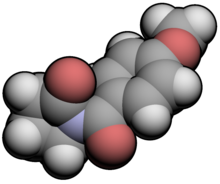- Aniracetam
-
Aniracetam 

Systematic (IUPAC) name 1-[(4-methoxybenzoyl)]- 2-pyrrolidinone Clinical data Trade names Ampamet, Memodrin, Pergamid AHFS/Drugs.com International Drug Names Pregnancy cat. ? Legal status Unscheduled Routes Oral Pharmacokinetic data Half-life 1-2.5 hours Identifiers CAS number 72432-10-1 
ATC code N06BX11 PubChem CID 2196 DrugBank DB04599 ChemSpider 2111 
UNII 5L16LKN964 
KEGG D01883 
ChEBI CHEBI:47943 
ChEMBL CHEMBL36994 
Chemical data Formula C12H13NO3 Mol. mass 219.237 g/mol SMILES eMolecules & PubChem  (what is this?) (verify)
(what is this?) (verify)Aniracetam (Draganon, Sarpul, Ampamet, Memodrin) is an ampakine and nootropic of the racetam chemical class purported to be considerably more potent than piracetam. It is lipid-soluble and has possible cognition-enhancing effects. It has been tested in animals extensively, Alzheimer's patients, and temporarily-impaired healthy subjects. It has shown potential as an anxiolytic in three clinical animal models. It is sold in Europe as a prescription drug.
Contents
Pharmacology
After a confirmed test of the anxiolytic efficacy in a mouse model, haloperidol, mecamylamine, and ketanserin were applied to determine the pathways aniracetam depends on to exert its anti-anxiety effects. Haloperidol completely reversed the anxiolytic effects, and mecamylamine and ketanserin nearly completely reversed the effects. This shows that aniracetam's anxiolytic mechanism is facilitated by D2/D3, nACh, and 5-HT2A receptors.[1]
Aniracetam has also been shown to selectively modulate the AMPA receptor[2] and was used as the parent compound to derive a class of drugs known as the ampakines that are being investigated as nootropics and neuroprotective drugs for the treatment of Alzheimer's disease and other neurodegenerative conditions.1
Despite the fat solubility of aniracetam, its half-life is much shorter than that of common racetam analogs such as piracetam.[citation needed]
Commonly used doses are 750-3,000 mg daily usually taken in 2-3 doses.
Side effects can include nausea and headache.[citation needed]
See also
References
- ^ Nakamura K; Kurasawa M (May 2001). "Anxiolytic effects of aniracetam in three different mouse models of anxiety and the underlying mechanism". Eur J Pharmacol. (Kanagawa, Japan). 420 (1): 33–43. doi:10.1016/S0014-2999(01)01005-6. PMID 11412837.
- ^ Ito et al. J. Physiol. 1990; 424: 533-543.
External links
Glutamatergics Ionotropic Agonists: 5-Fluorowillardiine • AMPA • Domoic acid • Quisqualic acid; Positive allosteric modulators: Aniracetam • Cyclothiazide • CX-516 • CX-546 • CX-614 • CX-691 • CX-717 • Diazoxide • HCTZ • IDRA-21 • LY-392,098 • LY-404,187 • LY-451,395 • LY-451,646 • LY-503,430 • Oxiracetam • PEPA • Piracetam • Pramiracetam • S-18986 • Sunifiram • Unifiram
Antagonists: ATPO • Barbiturates • Caroverine • CNQX • DNQX • GYKI-52466 • NBQX • Perampanel • Talampanel • Tezampanel • Topiramate; Negative allosteric modulators: GYKI-53,655Agonists: Glutamate/acite site competitive agonists: Aspartate • Glutamate • Homoquinolinic acid • Ibotenic acid • NMDA • Quinolinic acid • Tetrazolylglycine; Glycine site agonists: ACBD • ACPC • ACPD • Alanine • CCG • Cycloserine • DHPG • Fluoroalanine • Glycine • HA-966 • L-687,414 • Milacemide • Sarcosine • Serine • Tetrazolylglycine; Polyamine site agonists: Acamprosate • Spermidine • Spermine
Antagonists: Competitive antagonists: AP5 (APV) • AP7 • CGP-37849 • CGP-39551 • CGP-39653 • CGP-40116 • CGS-19755 • CPP • LY-233,053 • LY-235,959 • LY-274,614 • MDL-100,453 • Midafotel (d-CPPene) • NPC-12,626 • NPC-17,742 • PBPD • PEAQX • Perzinfotel • PPDA • SDZ-220581 • Selfotel; Noncompetitive antagonists: ARR-15,896 • Caroverine • Dexanabinol • FPL-12495 • FR-115,427 • Hodgkinsine • Magnesium • MDL-27,266 • NPS-1506 • Psychotridine • Zinc; Uncompetitive pore blockers: 2-MDP • 3-MeO-PCP • 8A-PDHQ • Alaproclate • Amantadine • Aptiganel • ARL-12,495 • ARL-15,896-AR • ARL-16,247 • Budipine • Delucemine • Dexoxadrol • Dextrallorphan • Dieticyclidine • Dizocilpine • Endopsychosin • Esketamine • Etoxadrol • Eticyclidine • Gacyclidine • Ibogaine • Indantadol • Ketamine • Ketobemidone • Loperamide • Memantine • Meperidine (Pethidine) • Methadone • Methorphan (Dextromethorphan, Levomethorphan) • Methoxetamine • Milnacipran • Morphanol (Dextrorphan, Levorphanol) • NEFA • Neramexane • Nitrous oxide • Noribogaine • Orphenadrine • PCPr • Phencyclamine • Phencyclidine • Propoxyphene • Remacemide • Rhynchophylline • Riluzole • Rimantadine • Rolicyclidine • Sabeluzole • Tenocyclidine • Tiletamine • Tramadol • Xenon; Glycine site antagonists: ACEA-1021 • ACEA-1328 • ACPC • Carisoprodol • CGP-39653 • CKA • DCKA • Felbamate • Gavestinel • GV-196,771 • Kynurenic acid • L-689,560 • L-701,324 • Lacosamide • Licostinel • LU-73,068 • MDL-105,519 • Meprobamate • MRZ 2/576 • PNQX • ZD-9379; NR2B subunit antagonists: Besonprodil • CO-101,244 (PD-174,494) • CP-101,606 • Eliprodil • Haloperidol • Ifenprodil • Isoxsuprine • Nylidrin • Ro8-4304 • Ro25-6981 • Traxoprodil; Polyamine site antagonists: Arcaine • Co 101676 • Diaminopropane • Acamprosate • Diethylenetriamine • Huperzine A • Putrescine • Ro 25-6981; Unclassified/unsorted antagonists: Chloroform • Diethyl ether • Enflurane • Ethanol (Alcohol) • Halothane • Isoflurane • Methoxyflurane • Toluene • Trichloroethane • Trichloroethanol • Trichloroethylene • XyleneAgonists: 5-Iodowillardiine • ATPA • Domoic acid • Kainic acid • LY-339,434 • SYM-2081
Antagonists: CNQX • DNQX • LY-382,884 • NBQX • NS102 • Tezampanel • Topiramate • UBP-302; Negative allosteric modulators: NS-3763Metabotropic Agonists: Unselective: ACPD • DHPG • Quisqualic acid; mGlu1-selective: Ro01-6128 • Ro67-4853 • Ro67-7476 • VU-71; mGlu5-selective: ADX-47273 • CDPPB • CHPG • DFB • VU-1545
Antagonists: Unselective: MCPG • NPS-2390; mGlu1-selective: BAY 36-7620 • CPCCOEt • LY-367,385 • LY-456,236; mGlu5-selective: Dipraglurant • DMeOB • Fenobam • LY-344,545 • MPEP • MTEP • SIB-1757 • SIB-1893Agonists: Unselective: L-AP4; mGlu4-selective: PHCCC • VU-001,171 • VU-0155,041; mGlu7-selective: AMN082; mGlu8-selective: DCPG
Antagonists: Unselective: CPPG • MAP4 • MSOP • MPPG • MTPG • UBP-1112; mGlu7-selective: MMPIPTransporter
inhibitorsDHKA • PDC • WAY-213,613vGluTs7-CKA • Evans blueRacetams Aloracetam • Aniracetam • Brivaracetam • Cebaracetam • Coluracetam • Dimiracetam • Doliracetam • Dupracetam • Etiracetam/Levetiracetam • Fasoracetam • Imuracetam • Molracetam • Nebracetam • Nefiracetam • Noopept • Oxiracetam • Phenylpiracetam • Piperacetam • Piracetam • Pramiracetam • Rolipram • Rolziracetam • Seletracetam
This drug article relating to the nervous system is a stub. You can help Wikipedia by expanding it.
